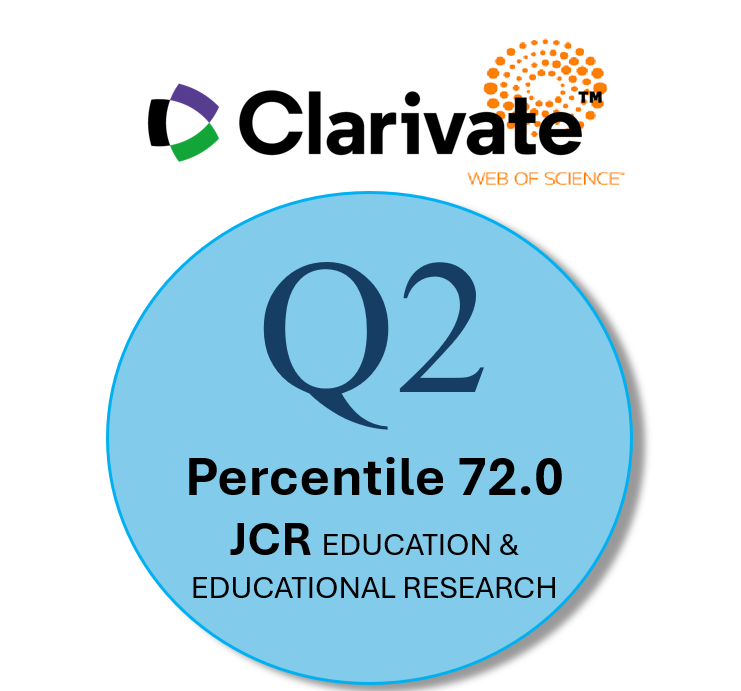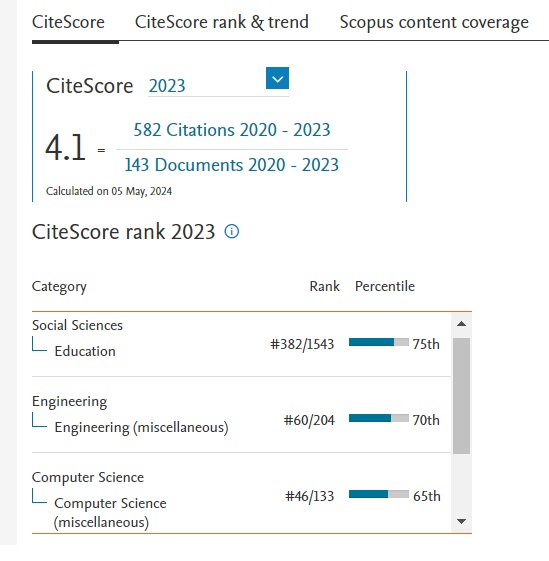Mapas de competencias genéricas del bachillerato
Resumen
En el marco general del diseño e implementación de un entorno virtual inteligente para dar seguimiento al desarrollo de competencias por los estudiantes, se presentan los resultados del análisis de las competencias genéricas establecidas para el Sistema Nacional de Bachillerato de México y la codificación de los resultados en la forma de mapas de competencias usando un lenguaje susceptible de ser procesado automáticamente por computadoras. Específicamente, se presentan una revisión de literatura sobre la representación computacional de competencias, un mapa de competencias genéricas con relaciones de subsume/es-un e incluye/parte-de y la aplicación del mapa para identificar la presencia de competencias genéricas en el diseño de cursos de bachillerato en el Sistema de Universidad Virtual de la Universidad de Guadalajara.
Descargas
-
Resumen780
-
PDF715
Citas
Berners-Lee, T. (2000, diciembre 6). Semantic Web—XML2000. World Wide Web Consortium (W3C). https://www.w3.org/2000/Talks/1206-xml2k-tbl/Overview.html
Biletska, O., Biletskiy, Y., Li, H., & Vovk, R. (2010). A semantic approach to expert system for e-Assessment of credentials and competencies. Expert Systems with Applications, 37, 7003–7014. https://doi.org/10.1016/j.eswa.2010.03.018
Brachman, R. J., & Levesque, H. J. (2004). Knowledge Representation and Reasoning. Morgan Kaufmann.
Chan, M. E., González, S. C., & Morales, R. (2010). A competency analyser as a knowledge-based approach for making e-learning more flexible and personalised. EDULEARN10 Proceedings CD. 2nd International Conference on Education and New Learning Technologies (Edulearn), 1607–1612. http://library.iated.org/view/CHAN2010ACO
Cicortas, A., Iordan, V., & Naaji, A. (2008). Ontologies for Competence Description in Multi-agent Systems. Computational Methods and Intelligent Systems, 100–107. http://www.wseas.org/multimedia/books/2008/sofia/computational-methods-and-intelligent-systems.pdf
Competency Data Working Group. (2008). 1484.20.1-2007 IEEE Standard for Learning Technology—Data Model for Reusable Competency Definitions (https://drive.google.com/drive/folders/0B1nfYUyald9QUmxkVURCcEs4WFE?usp=sharing). The Institute of Electrical and Electronics Engineers, Inc; Google Drive. http://ieeexplore.ieee.org/document/4445693/
El Asame, M., & Wakrim, M. (2018). Towards a competency model: A review of the literature and the competency standards. Education and Information Technologies, 23(1), 225–236. https://doi.org/10.1007/s10639-017-9596-z
Elsom-Cook, M. (1993). Student modelling in intelligent tutoring systems. 7(3–4), 227–240.
García-Barriocanal, E., Sicilia, M.-Á., & Sánchez-Alonso, S. (2012). Computing with competencies: Modelling organizational capacities. Expert Systems with Applications, 39, 12310–12318. https://doi.org/10.1016/j.eswa.2012.02.194
Holt, P., Dubs, S., Jones, M., & Greer, J. (1994). The State of Student Modelling. En J. Greer & G. I. McCalla (Eds.), Student Modelling: The Key to Individualized Knowledge-Based Instruction (pp. 3–35). Springer Verlag. https://link.springer.com/chapter/10.1007/978-3-662-03037-0_1
HR Open Standards Consortium. (2018). HR Open Standards 4.1.1 Patch. HR Open Standards Consortium. https://www.hropenstandards.org
IEEE. (2002). 1484.12.1 Standard for Learning Object Metadata. IEEE.
IHMC. (s/f). CXL – Concept Mapping Extensible Language [XML Schema Definition]. CmapTools. Recuperado el 5 de julio de 2021, de https://cmap.ihmc.us/xml/CXL.html
IMS Global Learning Consortium. (2002). IMS Reusable Definition of Competency or Educational Objective Specification (Version 1.0 Final Specification; p. 11). IMS Global Learning Consortium, Inc. http://www.imsglobal.org/competencies/index.html
IMS Global Learning Consortium. (2003). Learning Design Specification. IMS Global Learning Consortium, Inc. http://www.imsglobal.org/learningdesign/
Karampiperis, P., Sampson, D., & Fytros, D. (2006). Lifelong Competence Development: Towards a Common Metadata Model for Competencies Description – The Case Study of Europass Language Passport. Proceedings of the Sixth International Conference on Advanced Learning Technologies (ICALT’06), 677–681. https://www.computer.org/csdl/proceedings/icalt/2006/2632/00/263200136-abs.html
Lee, J. F., & Benati, A. G. (2009). Research and Perspectives on Processing Instruction. Walter de Gruyter.
Leenheer, P. D., Christiaens, S., & Meersman, R. (2010). Business semantics management: A case study for competency-centric HRM. Computers in Industry, 61(8), 760–775. https://doi.org/10.1016/j.compind.2010.05.005
Lefebvre, B., Gauthier, G., Tadie, S., Duc, T., & Achaba, H. (2005). Competence ontology for domain knowledge dissemination and retrieval. Applied Artificial Intelligence, 19(9–10), 845–859. https://doi.org/10.1080/08839510500234222
May, D., & Ossendorf, P. (2014). ModellING competences: Developing a holistic competence model for engineering education. 2014 International Conference on Interactive Collaborative Learning (ICL), 877–894. https://doi.org/10.1109/ICL.2014.7017902
Medina Flores, R., & Morales Gamboa, R. (2017). Mapa de competencias genéricas del Acuerdo 444 de la RIEMS para entornos virtuales inteligentes basados en competencias. Memorias del 8o. Coloquio Nacional de Educación Media Superior a Distancia. Octavo Coloquio Nacional de Educación Media Superior a Distancia, León, Guanajuato.
Miranda, S., Orciuoli, F., Loia, V., & Sampson, D. (2017). An ontology-based model for competence management. Data & Knowledge Engineering, 107, 55–66. https://doi.org/10.1016/j.datak.2016.12.001
Morales Gamboa, R., & Sucar, L. E. (Submited). Competence-Based Student Modelling with Dynamic Bayesian Networks [Paper submitted for publication]. arXiv:2008.12114. https://arxiv.org/abs/2008.12114
Nkambou, R., Lefebvre, B., & Gauthier, G. (1996). A Curriculum-Based Student Model for Intelligent Tutoring Systems. Proceedings of the Fifth International Conference on User Modelling, 91–98.
Object Management Group. (2003). OMG Unified Modeling Language Specification, Version 1.5. Object Monagement Group. https://www.omg.org/spec/UML/1.5
Paquette, G. (2007). Ontology and Framework for Knowledge and Competency Management. Knowledge Creation Diffusion Utilization.
Paquette, G., Léonard, M., Lundgren-Cayrol, K., Mihaila, S., & Gareau, D. (2006). Learning Design based on Graphical Knowledge-Modelling. Educational Technology & Society, 9(1), 97–112.
Pépiot, G., Cheikhrouhou, N., Furbringer, J.-M., & Glardon, R. (2007). UECML: Unified Enterprise Competence Modelling Language. Computers in Industry, 58, 130–142. https://doi.org/10.1016/j.compind.2006.09.010
Perrenoud, P. (2008). Construir competencias ¿es darle la espalda a los saberes? Revista de Docencia Universitaria, Número monográfico II: Formación centrada en competencias (II). http://revistas.um.es/redu/article/viewFile/35261/33781
Ramírez, C., & Sánchez, E. (2012). A Model for the Representation of Competences Applied to Student’s Knowledge Modelling. Research in Computing Science, 56, 77–85.
Rodríguez Yépez, M., & Morales Gamboa, R. (2019). Modelado de niveles de competencia por un sistema inteligente. Memorias CIIE 2019, 1078–1082.
Różewski, P., & Małachowski, B. (2009). Competence Management in Knowledge-Based Organisation: Case Study Based on Higher Education Organisation. En R. Goebel, J. Siekmann, & W. Wahlster (Eds.), Knowledge Science, Engineering and Management (pp. 358–369). Springer. https://doi.org/10.1007/978-3-642-10488-6_35
Różewski, P., & Małachowski, B. (2010). System for Creative Distance Learning Environment Development Based on Competence Management. En R. Setchi, I. Jordanov, R. J. Howlett, & L. C. Jain (Eds.), Knowledge-Based and Intelligent Information and Engineering Systems: Vol. Part IV (pp. 180–189). Springer. https://doi.org/10.1007/978-3-642-15384-6_20
Sampson, D., & Fytros, D. (2008). Competence Models in Technology-Enhanced Competence-Based Learning. En H. H. Adelsberger, Kinshuk, J. M. Pawlovski, & D. Sampson (Eds.), Handbook on Information Technologies for Education and Training (2a ed., pp. 155–177). Springer. https://link.springer.com/book/10.1007%2F978-3-540-74155-8
Sampson, D. G. (2009). Competence-related Metadata for Educational Resources that Support Lifelong Competence Development Programmes. Educational Technology & Society, 12(4), 149–159.
Sampson, D., Karampiperis, P., & Fytros, D. (2007). Developing a common metadata model for competencies description. Interactive Learning Environments, 15(2), 137–150. https://doi.org/10.1080/10494820701343645
Secretaría de Educación Pública. (2008, octubre 21). ACUERDO número 444 por el que se establecen las competencias que constituyen el marco curricular común del Sistema Nacional de Bachillerato. Diario Oficial de la Federación. http://dof.gob.mx/nota_detalle.php?codigo=5064951&fecha=21/10/2008
Sistema de Universidad Virtual. (2021). Bachillerato General por Áreas Interdisciplinarias (BGAI) [Página institucional]. Sistema de Universidad Virtual. http://udgvirtual.udg.mx/bachillerato
Sitthisak, O., Gilbert, L., Davis, H. C., & Gobbi, M. (2007). Adapting health care competencies to a formal competency model. ICALT 2007 - Proceedings of the 7th IEEE International Conference on Advanced Learning Technologies, 172–174.
Stoof, A., Martens, R. L., & Merriënboer, J. J. G. van. (2007). Web-based support for constructing competence maps: Design and formative evaluation. Educational Technology Research and Development, 55(4), 347–368. https://doi.org/10.1007/s11423-006-9014-5
VanLehn, K. (1988). Student Modelling. En M. C. Polson & J. J. Richardson (Eds.), Foundations of Intelligent Tutoring Systems (pp. 55–78). Lawrence Erlbaum Associates.
Vasconcelos, J. Â. B., Kimble, C., Ribeiro Gouveia, F., & Kudenko, D. (2001). Reasoning in corporate memory systems: A case study of group competencies. Proceedings of the 8th International Symposium on the Management of Industrial and Corporate Knowledge. 8th International Symposium on the Management of Industrial and Corporate Knowledge, Compiègne, France.
Wang, H.-F., & Wang, C. H. (2018). Modelling of Optimal Expansion of a Fuzzy Competence Set. International Transactions in Operational Research, 5(5), 413–424. https://doi.org/10.1111/j.1475-3995.1998.tb00124.x
World Wide Web Consortium. (2016, octubre 11). Extensible Markup Language (XML). World Wide Web Consortium (W3C). https://www.w3.org/XML/
Yu, P. L., & Zhang, D. (1990). A foundation for competence set analysis. Mathematical Social Sciences, 20(3), 251–299. https://doi.org/10.1016/0165-4896(90)90005-R
Zone of Proximal Development. (2009). En D. Matsumoto (Ed.), The Cambridge Dictionary of Psychology. Cambridge University Press.
Derechos de autor 2021 Revista de Educación a Distancia (RED)

Esta obra está bajo una licencia internacional Creative Commons Atribución-NoComercial 4.0.
Las obras que se publican en esta revista están sujetas a los siguientes términos:
1. El Servicio de Publicaciones de la Universidad de Murcia (la editorial) conserva los derechos patrimoniales (copyright) de las obras publicadas, y favorece y permite la reutilización de las mismas bajo la licencia de uso indicada en el punto 2.
2. Las obras se publican en la edición electrónica de la revista bajo una licencia Creative Commons Reconocimiento-NoComercial-SinObraDerivada 3.0 España (texto legal). Se pueden copiar, usar, difundir, transmitir y exponer públicamente, siempre que: i) se cite la autoría y la fuente original de su publicación (revista, editorial y URL de la obra); ii) no se usen para fines comerciales; iii) se mencione la existencia y especificaciones de esta licencia de uso.
3. Condiciones de auto-archivo. Se permite y se anima a los autores a difundir electrónicamente las versiones pre-print (versión antes de ser evaluada) y/o post-print (versión evaluada y aceptada para su publicación) de sus obras antes de su publicación, ya que favorece su circulación y difusión más temprana y con ello un posible aumento en su citación y alcance entre la comunidad académica. Color RoMEO: verde.














